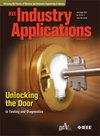Optimal Design and Operation of Long-Distance Deep-Water HVAC Transmission for Offshore WECS Integration With FPSO Unit
IF 4.5
2区 工程技术
Q2 ENGINEERING, ELECTRICAL & ELECTRONIC
引用次数: 0
Abstract
This paper evaluates the technical feasibility of integrating an offshore wind energy conversion system (WECS) into a floating production storage and offloading (FPSO) unit. The WECS is situated closer to the Brazilian mainland, requiring a 150 km long subsea umbilical cable for the integration with the FPSO unit. High voltage alternating current (HVAC) transmission is mandatory due to the substantial water depths, introducing challenges such as power losses and significant reactive capacitive current generated by the cable. This paper proposes a comprehensive approach to dealing with these challenges. Firstly, the umbilical cable section is sized based on ampacity and maximum current under short-circuit conditions. A power flow optimization is thus employed to determine the optimal transmission voltage that minimizes power losses. The optimization results define the reactive power that the back-to-back converter of the WECS must absorb based on the active power. This relationship is represented as a lookup table control, which ensures efficient operation by adjusting the reactive power reference in the WECS power control unit. Using this approach, the WECS back-to-back converter compensates for a portion of the reactive power generated by the umbilical, reducing the need for additional infrastructure such as shunt reactors or reactive compensation substations. Each component of the system is modeled, and a complete simulation is conducted using MATLAB/Simulink to validate the proposal. The results demonstrate the effectiveness of this approach in enhancing system efficiency while significantly reducing carbon dioxide emissions during oil and gas exploration through the integration of WECS with FPSO units.海上WECS与FPSO装置集成的长距离深水HVAC系统优化设计与运行
本文评估了将海上风能转换系统(WECS)集成到浮式生产储卸(FPSO)装置中的技术可行性。WECS位于巴西大陆附近,需要一条150公里长的海底脐带电缆与FPSO装置集成。由于水深较大,高压交流电(HVAC)传输是强制性的,这带来了电力损耗和电缆产生的大量无功电容电流等挑战。本文提出了应对这些挑战的综合方法。首先,根据短路条件下的容量和最大电流来确定脐带电缆截面的尺寸。因此,采用潮流优化来确定使功率损耗最小化的最佳传输电压。优化结果在有功功率的基础上确定了无功功率系统背靠背变流器必须吸收的无功功率。这种关系表示为一个查找表控制,它通过调整WECS功率控制单元中的无功功率参考来确保高效运行。使用这种方法,WECS背靠背转换器补偿了脐带缆产生的部分无功功率,减少了对分流电抗器或无功补偿变电站等额外基础设施的需求。对系统的各个组成部分进行了建模,并利用MATLAB/Simulink进行了完整的仿真验证。结果表明,通过将WECS与FPSO设备集成,该方法在提高系统效率的同时显著减少了油气勘探过程中的二氧化碳排放。
本文章由计算机程序翻译,如有差异,请以英文原文为准。
求助全文
约1分钟内获得全文
求助全文
来源期刊

IEEE Transactions on Industry Applications
工程技术-工程:电子与电气
CiteScore
9.90
自引率
9.10%
发文量
747
审稿时长
3.3 months
期刊介绍:
The scope of the IEEE Transactions on Industry Applications includes all scope items of the IEEE Industry Applications Society, that is, the advancement of the theory and practice of electrical and electronic engineering in the development, design, manufacture, and application of electrical systems, apparatus, devices, and controls to the processes and equipment of industry and commerce; the promotion of safe, reliable, and economic installations; industry leadership in energy conservation and environmental, health, and safety issues; the creation of voluntary engineering standards and recommended practices; and the professional development of its membership.
 求助内容:
求助内容: 应助结果提醒方式:
应助结果提醒方式:


